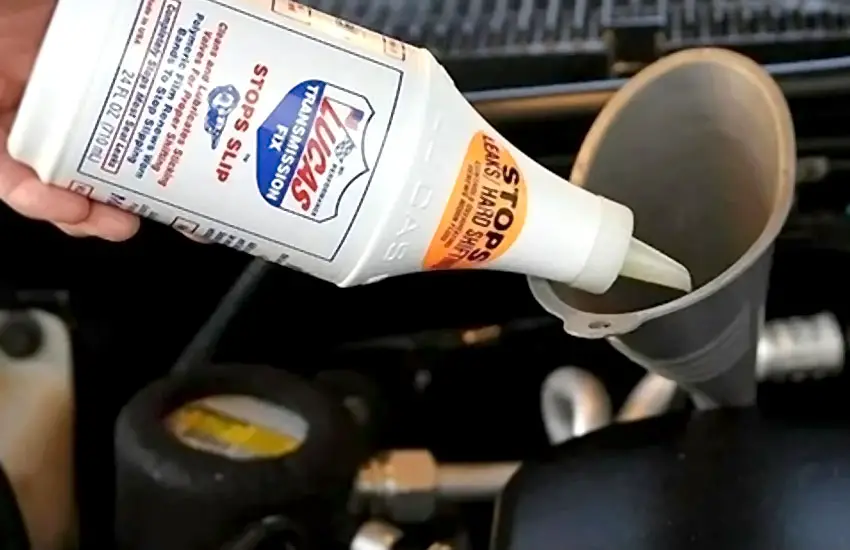As an Amazon Associate, I earn from qualifying purchases at no extra cost to you.
How to Use Lucas Transmission Fix: Simple Steps!
You might be wondering how to make your car’s transmission work better without spending a lot of money. Lucas Transmission Fix is a simple solution that can help with slipping, leaks, and rough shifting. In this post, we’ll show you how to use it step by step. No need to worry, it’s easy to do, and you don’t need to be a car expert. By the end, you’ll know how to give your transmission a quick and affordable boost.

How to Use Lucas Transmission Fix: Step-by-Step Guide
Check the Transmission Fluid Level
Before you begin using Lucas Transmission Fix, the first step is to check the transmission fluid level in your car. Transmission fluid is a special liquid that helps keep your transmission working smoothly. If the fluid is too low, it can cause problems like slipping gears or rough shifting. Checking the fluid level is easy, but you need to know where to look.
Start by finding the transmission fluid dipstick in your car. It's usually located near the engine, and it looks like a long stick with a handle. Once you find it, pull the dipstick out carefully. The tip of the dipstick will be covered in transmission fluid, so grab a clean cloth and wipe it off. This helps you get an accurate reading of the fluid level.
Now, put the dipstick back into its place and pull it out again. Look at the fluid on the dipstick. There are markings that show if the fluid level is too low, too high, or just right. If the level is too low, then it’s a good idea to add more fluid. If it's okay, then you’re ready to add Lucas Transmission Fix.
Remember, the color of the fluid also matters. Fresh transmission fluid is usually red or pink, while old fluid turns brown or black. If the fluid looks dirty or smells burnt, it might be a sign that you need a transmission fluid change. Keeping an eye on the fluid level and its condition can help prevent bigger problems down the road.
Add Lucas Transmission Fix
Once you’ve checked the transmission fluid level, the next step is to add the Lucas Transmission Fix. This part is very simple, but you need to take your time and do it carefully.
First, take the bottle of Lucas Transmission Fix and give it a good shake. This ensures that everything inside the bottle is mixed properly. Now, find the transmission fill port on your car. This is where you add transmission fluid, and it's often located near the same spot where you found the dipstick. Make sure your car is turned off before you begin.
Carefully open the fill port by removing the cap. Take your bottle of Lucas Transmission Fix and slowly pour the contents into the fill port. Since the product is thick, it might take a little while to pour it all in. Be patient and avoid spilling it. Pouring too fast can cause the fluid to overflow.
After you've poured the Lucas Transmission Fix into the transmission, make sure to replace the fill port cap securely. Tighten it well to avoid any leaks. Adding Lucas Transmission Fix helps the transmission fluid work better and can stop leaks, reduce slipping, and improve shifting performance.
One important thing to remember is that you shouldn't overfill the transmission. Adding too much fluid can cause issues, so it’s best to follow the directions on the bottle and keep an eye on the fluid level as you go.
Drive Your Car
After adding Lucas Transmission Fix, the next step is to drive your car. This is an important part of the process because driving helps the Lucas Transmission Fix spread through the entire transmission system. As the product circulates, it starts to work on fixing leaks, smoothing out gear shifts, and reducing slipping.
When you start driving, try to drive like you normally would. You don't need to do anything special; just let the transmission work as you go. You may not notice an immediate change, but over time, the Lucas Transmission Fix will begin to make a difference. The more you drive, the more it will spread throughout the transmission, making it smoother and more efficient.
Pay close attention to how your car feels while you drive. You should start noticing improvements in how the car shifts gears. If you had problems with slipping or jerky shifts before, you might notice that the transmission feels more responsive and steady. The Lucas Transmission Fix works by filling in small gaps in the transmission seals, which can help stop leaks and improve overall performance.
It's also a good idea to listen for any changes in sound. If your transmission was making strange noises before, like whining or grinding, those sounds might start to fade as the Lucas Transmission Fix does its job. Just be patient and give the product some time to work through your car’s system.
Check the Results
After you've driven your car for a while, it's time to check if the Lucas Transmission Fix has made a difference. This step is all about seeing the results of the work you've done so far. You want to make sure that the product is helping your transmission perform better.
Start by inspecting your car's transmission for leaks. Look under the car and around the transmission area to see if there's any fluid dripping. If you notice leaks, the Lucas Transmission Fix may need a little more time to fully seal them. In many cases, the product will stop leaks after a few days of driving.
Next, test how your car shifts gears. Take it for a short drive and pay attention to how smoothly the gears change. If the Lucas Transmission Fix is working, you should notice smoother shifts with less hesitation. If you were experiencing gear slipping before, this problem might have improved or gone away completely.
Also, pay attention to how your car feels overall. If the Lucas Transmission Fix has worked well, your car should feel more stable when shifting gears, and you might even notice a quieter transmission. It’s a good sign if your car feels better than it did before.
If you don’t see immediate results, don’t worry. Sometimes it takes a few days or even a week of driving before the Lucas Transmission Fix fully kicks in. Keep monitoring the transmission’s performance and checking for leaks, and you should see improvements over time.
When to Use Again
Knowing when to use Lucas Transmission Fix again is key to keeping your transmission in good condition. You can use it regularly as part of your car's maintenance routine, or you can add it whenever you notice problems with your transmission.
One good time to use Lucas Transmission Fix is during a transmission fluid change. Changing your transmission fluid helps keep everything running smoothly, and adding Lucas Transmission Fix during this process can extend the life of your transmission even further. Many people choose to add it every time they change the fluid to prevent leaks and improve shifting performance.
Another time to use Lucas Transmission Fix is when you notice any signs of trouble with your transmission. If your car starts slipping, making strange noises, or leaking fluid, adding Lucas Transmission Fix might help solve the problem. However, keep in mind that while it can help with minor issues, it may not fix serious mechanical problems. In those cases, you might need a mechanic's help.
By keeping an eye on your car's performance and using Lucas Transmission Fix when needed, you can avoid bigger transmission problems in the future. Regular use of this product can help your transmission last longer, saving you from costly repairs.
I hope this guide helps you use Lucas Transmission Fix easily. It’s a simple way to keep your car’s transmission running smoothly. Just follow the steps carefully, and you’ll see the benefits. Remember, regular maintenance can prevent bigger issues and keep your car in great shape.
Important Tips
When using Lucas Transmission Fix, it’s important to follow some key tips to get the best results. These tips will help you avoid problems and make sure your transmission stays in good condition.
Don't Overfill the Transmission
One of the most important things to remember is not to overfill your transmission. Adding too much fluid can create pressure inside the transmission, leading to leaks or other issues. Always check the fluid level before you add Lucas Transmission Fix. If the fluid level is already full, you might need to remove some fluid before adding the product. This way, you ensure that your transmission has the right amount of fluid.
Use the Right Amount
Another important tip is to use the right amount of Lucas Transmission Fix. Each bottle has instructions on how much to add, so be sure to follow them carefully. Adding too much can cause problems, just like overfilling the transmission. If you're not sure how much to use, it's better to add a little less and see how it works. You can always add more later if needed.
Be Patient
Lucas Transmission Fix is a great product, but it might take some time to see the full results. After adding it, drive your car for a few days to let the product work through the system. Don't expect instant results—give it time to do its job. Over time, you should notice smoother shifting and reduced slipping. If you don't see results right away, be patient and keep driving your car as usual.
Regular Maintenance
Finally, consider using Lucas Transmission Fix as part of your regular car maintenance. You can add it during every transmission fluid change or when you notice signs of trouble, like slipping or leaks. Regular use can help keep your transmission running smoothly and extend its life. This simple step can save you money on costly repairs and keep your car in good condition for longer.
Frequently Asked Questions
How often should I use Lucas Transmission Fix?
You can use Lucas Transmission Fix during every transmission fluid change or whenever you notice problems like slipping or leaks. Regular use can help maintain your transmission’s performance and extend its life.
Can Lucas Transmission Fix stop all leaks?
Lucas Transmission Fix can stop many types of transmission leaks, especially those caused by worn seals. However, if the leak is severe or caused by a bigger problem, you might need professional repair.
How long does it take for Lucas Transmission Fix to work?
It can take a few days of regular driving for Lucas Transmission Fix to fully circulate through your transmission and show results. Be patient and give the product time to work.
Is Lucas Transmission Fix safe for all types of vehicles?
Yes, Lucas Transmission Fix is safe for use in most automatic and manual transmissions. However, it's always a good idea to check your car's manual or consult a mechanic if you're unsure.
Can I use Lucas Transmission Fix in a manual transmission?
Yes, Lucas Transmission Fix can be used in both automatic and manual transmissions. It helps improve shifting and reduces wear in both types of transmissions.
Will Lucas Transmission Fix fix a slipping transmission?
Lucas Transmission Fix can help reduce or stop transmission slipping by improving the performance of worn transmission parts. If the slipping is caused by severe damage, you may need a professional repair.
Can I add Lucas Transmission Fix without draining the transmission fluid?
Yes, you can add Lucas Transmission Fix directly to your transmission without draining the fluid. Just be sure not to overfill the transmission by checking the fluid level before adding the product.
Does Lucas Transmission Fix work immediately?
Lucas Transmission Fix might not show immediate results. It usually takes a few days of driving for the product to fully work through the system and improve transmission performance.
Can Lucas Transmission Fix be used as a preventive measure?
Yes, using Lucas Transmission Fix as part of your regular maintenance can help prevent future transmission problems, such as leaks and slipping. It's a good way to keep your transmission in top condition.
What should I do if Lucas Transmission Fix doesn't solve the problem?
If Lucas Transmission Fix doesn't fix the issue after a few days of driving, it might mean the problem is more serious. In this case, it's best to take your car to a mechanic for a professional diagnosis and repair.











